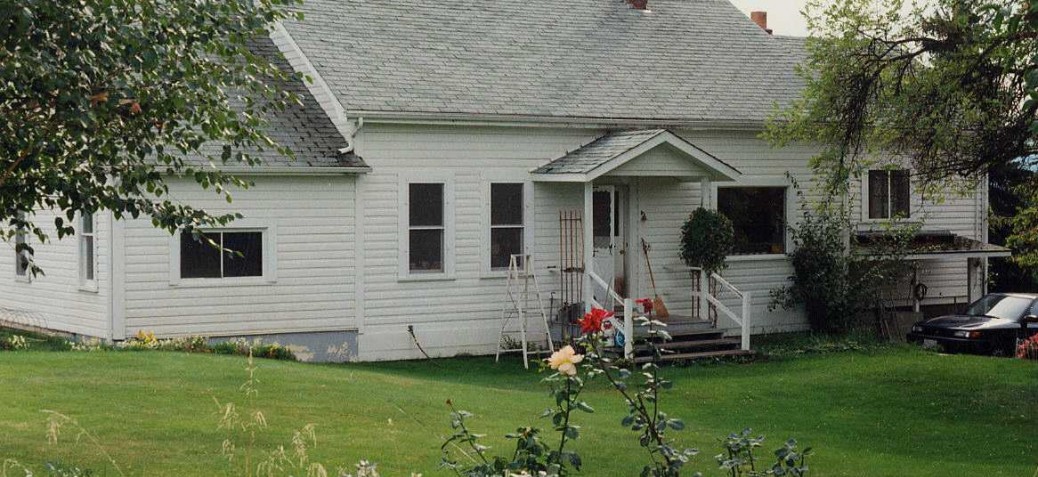Pooley House
Place Description
The historic place is the early, single-storey Pooley House, built in stages between about 1904 and 1913 at 3690 Pooley Road, on benchland in the agricultural East Kelowna sector of the City of Kelowna.
Heritage Value
The house has heritage value for being one of the first built on the East Kelowna benches, for its association with the Pooley and Dendy families, both important in early Kelowna history, for its association with orcharding and agricultural land development, and for its likely builder, H.W. Raymer.
The house was built as the home of W.R. Pooley, one of the promoters of the Kelowna Land and Orchard Company, which started the development of large-scale irrigated orchards in the Kelowna area. It sits at the east end of Pooley Road, named for him, and at the intersection of another, which was named for his partner E.M. Carruthers (until the name was changed from Carruthers Road to Bemrose Road in the 1980s, to avoid emergency services confusion with Carruthers Street in central Kelowna). The orchard has been continuously operated ever since, and the house is currently occupied by the son of another early East Kelowna settler.
Walter Robert ('Bob') Pooley, born in a middle-class English family, arrived in Kelowna in 1902 and set up a real estate business in partnership with E.M. Carruthers, who had been here since 1890. Carruthers had an idea for irrigating the dry benchlands, then only cattle range, but lacked capital. In 1904 Pooley and T.W. Stirling (who also came from the United Kingdom, and whose former house stands at 2124 Pandosy Street) bought 6,473 acres, lying south and east of the townsite of Kelowna, from the Lequime family, the pioneer settlers of the area. This land they transferred to their Kelowna Land and Orchard Company, which, as well as opening up a new residential area immediately across Mill Creek from the original townsite, subdivided farm lots along the eponymous KLO Road and orchard lots (irrigated with water from Canyon Creek) of from one to forty acres on the East Kelowna benches.
This house, built on the orchard lot Bob Pooley retained for himself (one of the first orchards planted in East Kelowna), was built in 1904 or 1905. It is believed to have been built by H.W. Raymer (the first mayor of Kelowna, who built a large share of early Kelowna), since lumber with his name on it was found during renovations. The initial construction, the west end of the present building, was a hipped-roof cottage, a necessary constraint because Pooley's capital was tied up in the development schemes. Of particular interest is the hanging or bracket chimney (no longer in use) in the kitchen, a form of construction that would contravene modern building codes. The rest of the house was built before the First World War, as profits from the development and orchard operation allowed the expenditure. Pooley reportedly had the first telephone on the benches, in 1906.
The KLO Company fell victim to the financial slump of 1913 and the cessation of immigration during WWI, and finally went into bankruptcy in 1923. W.R. Pooley died in 1915, and his widow I.G. Pooley spent many years paying off debts on the property.
Pooley's son, Nigel R.C. Pooley, carried on the operation of the orchard after he grew up, except for war service from 1940 to 1945. At the time of his death in 1968, Nigel was president of Fruit Growers' Mutual Insurance Company, an important local institution created in 1955.
In 1972 the house and orchard were sold to H. D'Arze Dendy, whose own father had been one of the early settlers on the lower bench in East Kelowna, and who still lives in the house.
Character Defining Elements
- Core is a simple, square, hipped-roof cottage, which still able to be discerned
- Extensions at either end elongated the house and made it irregular in form, and maintain the cottage character
- House well set back from road with large lawn, flower beds and numerous mature trees
- Cottage style centre portion with wings
- Brick chimney and some wood windows and trim are original
- Mature trees on the grounds




